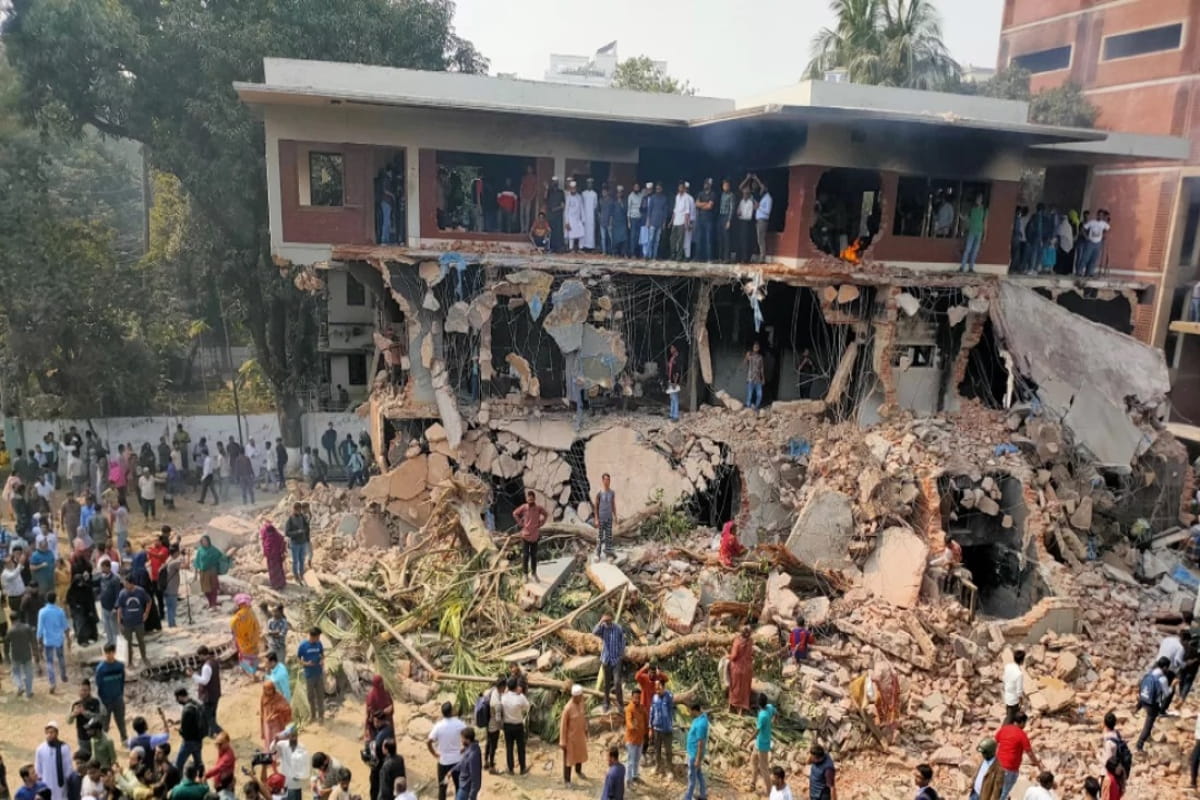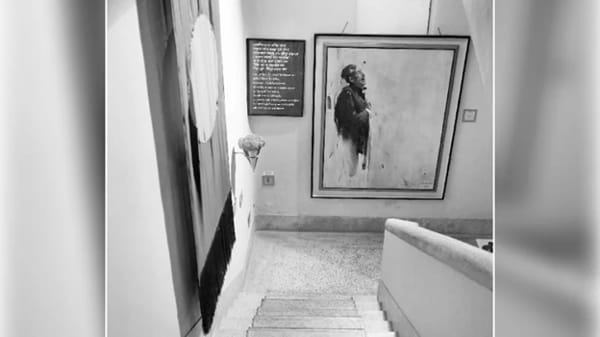
A crowd gathered the day after the destruction of Dhanmondi 32 to witness the aftermath. | Mahmud Hossain Opu/Dhaka Tribune.
Bangabandhu’s home has been reduced to rubble by mobs unhappy with the history of Bangladesh. But 32 Dhanmondi remains, as it will always remain, our claim on the glory that was Bangabandhu’s politics, on the history which Bengalis forged for themselves in the defining era of the 1960s stretching into the 1970s.
32 Dhanmondi: An Embodiment of National History
Every time the Ayub Khan regime decided to take Bangabandhu Sheikh Mujibur Rahman into custody in the 1960s, its soldiers turned up at 32 Dhanmondi and took him away. They did nothing that would damage his home.
When Pakistan’s soldiers turned up at 32 Dhanmondi as March 25 gave way to March 26 in 1971, they seized the Father of the Nation and took him away. His family was not touched and neither was his home.
On 15 August 1975, assassins shot their way into 32 Dhanmondi, murdered the founder of the Bengali nation and his family and left the residence floating in a sea of blood. The eerie silence across the residence was all.
It would stay that way for six years, until Sheikh Hasina came home from exile to reclaim the legacy of the Father of the Nation
It is a place suffused in history. It is the embodiment of national history.
The home of Bangabandhu Sheikh Mujibur Rahman at Road 32 Dhanmondi was in the 1960s and till the mid-1970s a proper centre of Bengali nationalistic aspirations. Today it is a hallowed spot, testimony to the supreme struggle and equally supreme sacrifices which are the legacy of the Father of the Nation and his family. It was here that a nearly entire family was gunned down by the forces of darkness in August 1975.
And once the orgy of murder was complete, the assassin-soldiers went around looking for any valuables they could find. They left all the rooms in absolute chaos. The photographs on the walls had been shot through and so were other objects in that residence, a home like any other middle-class Bengali home. On the walls were marks of blood and brain tissue. On the floor lay shells of the bullets that had gone into the killing operation.
32 Dhanmondi becomes Sheikh Mujibur Rahman Memorial Museum

The staircase at Bangabandhu Memorial Museum where Bangabandhu Sheikh Mujibur Rahman was assassinated along with a majority of his family members on August 15, 1975. | Collected photo.
Today, reinvented as Bangabandhu Sheikh Mujibur Rahman Memorial Museum, 32 Dhanmondi stands tall as a symbol of the greatest moments in the history of the Bengali nation and, again, as evidence of the darkest moment in the history of this land. It was from this home that Bangabandhu directed the non-cooperation movement in March 1971.
It was in the sitting room on the ground floor that he met visitors, among whom were Khan Abdul Wali Khan, Air Marshal Asghar Khan, Ghaus Bux Bizenjo and so many others. It was also, in those days of creative tumult, the spot where tens of thousands of Bengalis converged day after day, to let the future founding father of the country know that they were behind him in his mission of attaining liberty for the nation.
At 32 Dhanmondi in August 1975, Bangabandhu’s Bengalis did to him what his historical tormentors in the form of successive Pakistani military regimes could not do despite the power and the authority they were privy to. In the 1960s, it was here that Pakistan’s police turned up with warrants for Sheikh Mujibur Rahman’s arrest. And those warrants kept coming, one after another. On 8 May 1966, Bangabandhu got into a police van and was taken away to Dhaka Central Jail under the Defence of Pakistan Rules. He was now in detention over his recently announced Six Point Programme of regional autonomy for the federating units of the state of Pakistan.
In early 1968, he was transferred to Dhaka cantonment as the leading accused in the Agartala Conspiracy Case initiated by the Ayub Khan regime. On 22 February 1969, free of the case by dint of a mass movement and ready to provide leadership to the nation in the aftermath of the popular triumph against the regime of Ayub Khan, Mujib returned to 32 Dhanmondi from captivity in the Dhaka cantonment. He would be anointed Bangabandhu by a grateful nation the next day.
In the early minutes of 26 March 1971, 32 Dhanmondi came under attack from the Pakistan army. Armoured vehicles and truckloads of soldiers shot their way through the street beside the lake until they pulled up before Bangabandhu’s residence. A hail of bullets left holes through the gate. Other bullets went flying up and across, to pierce the doors and windowpanes of the building. At that point Bangabandhu emerged on the balcony and, raising his voice, asked the soldiers to stop firing. “I am here”, he told them.
Minutes later, he was in an army van. The soldiers whisked him off to the cantonment as other soldiers of the Pakistan army put the city of Dhaka to the torch. Detained in Adamjee Cantonment College for a few days, Bangabandhu was flown to solitary imprisonment --- with no contact with the outside world, no radio and no newspapers --- in Mianwali in West Pakistan. His family, in detention, was soon moved to Road 18. The Army kept 32 Dhanmondi under its control.
Life and all the vibrancy and energy symbolized by it returned to 32 Dhanmondi days after Bangabandhu Sheikh Mujibur Rahman, freed by a Pakistan defeated in war and now leader of a newly-independent Bangladesh, returned home on 10 January 1972. It was once more home, the abode to which the Father of the Nation went back every evening after his day’s work had been done at Ganobhavan.
On his final day alive, Bangabandhu welcomed a special representative of South Korean President Park Chung-hee at Ganobhavan. Before going home, he saw to it that arrangements for a farewell for Mohammad Farashuddin, a bright and trusted officer on his staff preparing to go abroad for higher studies, were in place.
He was also briefed by officials about his planned visit to Dhaka University the following morning. As the afternoon began to give way to twilight, Bangabandhu sat on the steps of the lake at Ganobhavan, in the company of Prime Minister M. Mansoor Ali. He was serene, relaxed. So was Mansoor Ali.
And then Bangabandhu went home.
In the pre-dawn hours of the next day, 32 Dhanmondi came under attack once again, this time from renegade soldiers of the Bangladesh army. In March 1971, Pakistan’s soldiers did not murder Bangabandhu. In August 1975, Bangladesh’s soldiers felt no such qualms in killing the man whose long political struggle had given them the army they were now putting to use in physically eliminating him.
Silence and Shame
And we said not a word. Except for the brave patriot Brigadier Jamiluddin Ahmed, none of us went out on the streets in protest. None of the chiefs of the armed forces organized any resistance but coolly went ahead, hours after the carnage had been committed, with swearing fealty to the usurper regime installed by the assassins.
Not a single minister, till the other day in genuflection before Bangabandhu for favours, declined to be part of the Moshtaque cabal. Not one of them protested the killing of the Father of the Nation. Not one of them went to 32 Dhanmondi to pay respects to their assassinated leader.
It was our moment of collective shame. All these decades after the cataclysm, we weep for Bangabandhu, for those who died with him. All those years ago, all of us willingly and willfully embraced cowardice and stayed home. A handful of uniformed murderers had commandeered the country. We let them.
We live in the shadow of our shame. It is our sin. We will live in infamy because of the courage we did not show forty-seven years ago. It was our ingratitude to our leader that cast a sinister shadow across the land. We keep paying the price, close to five decades on. Our penitence at our sin goes on.
Bangabandhu’s home has been reduced to rubble by mobs unhappy with the history of Bangladesh. But 32 Dhanmondi remains, as it will always remain, our claim on the glory that was Bangabandhu’s politics, on the history which Bengalis forged for themselves in the defining era of the 1960s stretching into the 1970s.
(Exclusive to NatStrat)